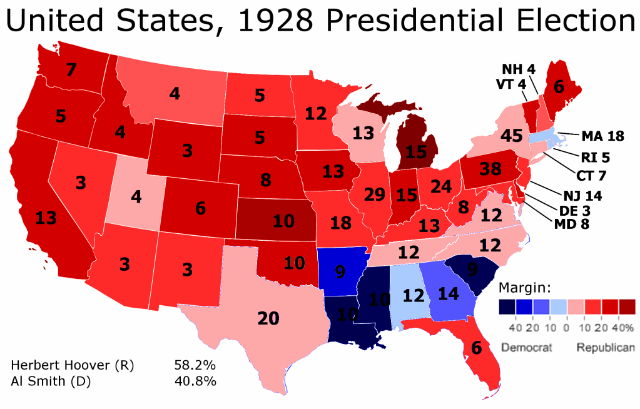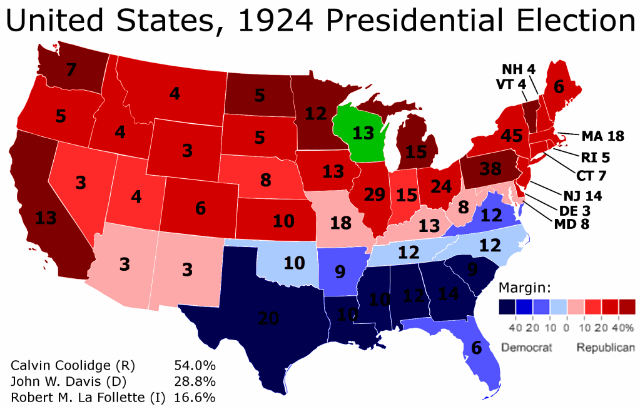This is the last part of three posts analyzing the Democratic Party’s struggles during the 1920s, when it lost three consecutive presidential elections by landslide margins. This will focus upon the 1928 presidential election, when the Democratic Party began to change into what it is today.
The 1928 Presidential Election
The 1928 presidential election marked the beginning of a great shift in American politics. It was when the Democratic Party started changing from a minority and fundamentally conservative organization into the party that would nominate Senator Barack Obama for president.
More below.
All this was quite far off in 1928, however. All Democrats knew was that they had just lost two landslide elections. In 1920 and 1924, the Democratic Party had won the votes of white Southerners – and nobody else. Their last candidate had won barely more than one-fourth of the vote.
In 1928 the Democratic Party tried a different strategy. It nominated Governor Al Smith of New York, the candidate of its white ethnic constituency. In the 1920 and 1924 these voters had sat out the first election, and then voted for a third-party candidate. Mr. Smith was a Tammany Hall-bred politician and a life-long New Yorker who identified as an Irish-American.
There was just one problem: Mr. Smith was not a Christian. Rather, he was a Roman Catholic who many feared would take orders from the Pope himself.
White ethnics had abandoned the Democratic Party in the two previous presidential elections. This time it was the turn of white Southerners, who voted Republican in unprecedented numbers:
White Southerners may have been willing to vote for a yellow dog for president, but many drew the line at voting for a Catholic (especially one who wanted to condemn the Klu Klux Klan and supported anti-lynching legislation).
It was Republican candidate Herbert Hoover who benefited from this. Riding a strong economy and a wave of personal popularity, Mr. Hoover defeated Mr. Smith by 17.2% – a landslide on par with President Ronald Reagan’s pummeling of Democratic candidate Walter Mondale, or Mr. Hoover’s own defeat four years later.
The Transformation of the Democratic Party
The 1928 presidential election was the first time white Southerners had abandoned the Democratic Party since the Civil War, and it signaled the beginning of a sea change in American politics.
Amidst all the Republican celebration of a third massive Republican landslide, there was one disquieting sign: Democrats won more than 50% of the vote in Massachusetts, for the first time in history. Irish-American support also gained Mr. Smith more than 50% in Rhode Island (for the first time since 1852). In New York Democrats lost by less than three percent.
Thus, while white Southerners voted more Republican than ever before in the history of the Republican Party, white ethnics in the Northeast and Midwest supported their fellow Catholic in unprecedented numbers. In 1928, both Mississippi and Massachusetts voted Democratic, as the party lost by a landslide.
In the ensuing decades, the Democratic Party’s power base would shift in a slow but sure tide towards Massachusetts and away from Mississippi. 1928 was the first time Democrats relinquished much of the White Southerner vote, but it would not be the last. President Franklin D. Roosevelt stopped the trend for a generation, but after him it would resume. Democrats would become the party of Massachusetts, not the party of Mississippi.
This trend started in 1928. A comparison of the 1924 and 1928 presidential elections is revealing. In 1924, Democrats still held a lock on the South, while Republicans held a lock everywhere else:
In 1928 this began changing. Democratic strength began to move away from the South, and towards the Northeast and Midwest:
This change continues to this very day.
Conclusions
In 1928, one could be forgiven for thinking that the Democrats were consigned to permanent minority status. They had just lost three presidential landslide elections in a row. They had not controlled a House of Congress for more than a decade.
Indeed, aside from 1912 (when two Republicans split the vote), the Democratic Party had won exactly one presidential election since 1892. They had won more than 50% of the vote just one time since the Civil War; Republicans had done so nine times during the same period.
In 1928, the Democratic Party really did seem trapped as a regional-based party which had great trouble competing outside the South. Again and again, Democratic candidates were pummeled outside the former Confederacy. When they had attempted to reach out to white ethnics in 1928, White Southerners had refused to go along.
It was a terrible Catch-22, a problem Democrats had failed to surmount for almost two generations. In the end, it would take a Great Depression for them to do so.
–Inoljt, http://mypolitikal.com/


